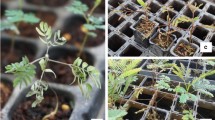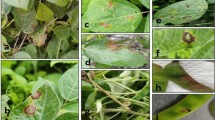Abstract
Fusarium graminearum is the predominant pathogen causing fusarium head blight of cereals in North America. Fifteen Canadian isolates of Fusarium graminearum were highly diverse in terms of vegetative compatibility grouping (VCG) and varied for production of ergosterol and mycotoxin production in rice culture. Aggressiveness was assessed by scoring the disease severity incited in wheat spikes by each isolate. Two inoculation methods, single-floret injection and spray of entire spikes, were used to screen 4 wheat varieties for reaction to the F. graminearum isolates. All isolates were of broadly similar aggressiveness, with disease severity ranging from 17.2 to 39.1 for single floret injection, and 39.1 to 69.0 for spray inoculation. Disease severity, ergosterol production, and mycotoxin development were not correlated. Using nitrate non-utilizing mutants the 15 isolates were grouped into 14 VCGs. Deoxynivalenol (DON) was produced by all isolates in rice culture, at levels between 0.2 and 249 ppm. 15-acetyldeoxynivalenol was produced by 14 of the 15 isolates at levels between 0.4 and 44.6 ppm. These results reveal a high level of diversity for several characteristics among F. graminearum isolates from Canada.
Similar content being viewed by others
References
Atanassov Z, Nakamura C, Mori N, Kaneda C, Kato H, Jin Y-Z, Yoshizawa T, Muria K. Mycotoxin production and pathogenicity of Fusarium species and wheat resistance to fusarium head blight. Can J Bot 1994; 72: 61–167.
Booker NL, Leslie JF, Dickman MB. Nitrate non-utilizing mutants of Colletotrichum and their use in studies of vegetative compatibility and genetic relatedness. Phytopathology 1991; 81: 672–677.
Bowden RL, Leslie JF. Nitrate-nonutilizing mutants of Gibberella zeae (Fusarium graminearum) and their use in determining vegetative compatibility. Exp Mycol 1992; 16: 308–315.
Bowden RL, Leslie JF. Diversity of Gibberella zeae at small spatial scales. Phytopathology 1994; 84: 1140.
Dusabenyagasani M, Hamelin RC, Collin J, Dostaler D. Importance de l'interaction entre les cultivars de blé et les souches du Fusarium graminearum dans l'évaluation de la résistance à la fusariose de l'épi. Phytoprotection 1997; 78: 53–60.
Eeuwijk van FA, Mesterházy Á, Kling CI, Ruckenbauer P, Saur L, Bürstmayr H, Lemmens M, Keizer LCP, Maurin N, Snijders CHA. Assessing non-specificity of resistance in wheat to head blight caused by inoculation with European strains of Fusarium culmorum, F. graminearum and F. nivale using a multiplicative model for interaction. Theor Appl Genet 1995; 90: 221–228.
Gessner MO, Schmitt AL. Use of solid-phase extraction to determine ergosterol concentrations in plant tissue colonized by fungi. Appl Microbiol 1996; 62: 415–419.
Gilbert J, Tekauz A. Review: Recent developments in research on fusarium head blight of wheat in Canada. Can J Plant Pathol 2000; 22: 1–8.
Lamper Cs, Téren J, Bartók T, Komorócky R, Mesterházy Á, Sági F. Predicting DON contamination in Fusarium-infected wheat grains via determination of the ergosterol content. Cer Res Commun 2000; 28: 337–344.
McCallum BD, Tekauz A, Gilbert J. Vegetative compatibility among Fusarium graminearum (Gibberella zeae) isolates from barley spikes in southern Manitoba. Can J Plant Pathol 2001; 23: 83–87.
Mesterházy Á, Bartók T. Resistance, pathogenicity and Fusarium spp. influencing toxin (DON) contamination of wheat varieties. In Arseniuk E and Góral T. eds. Proceedings of the 3rd European Seminar on Fusarium – Mycotoxins, Taxonomy, Pathogenicity and Host Resistance. Radzików, Poland. Hod Ro´s l Aklim Nasien 1992; 37(3), 9–15.
Miedaner T, Schilling AG. Genetic variation of aggressiveness in individual field populations of Fusarium graminearum and Fusarium culmorum tested on young plants of winter rye. Eur J Plant Pathol 1996; 102: 823–830.
Miller JD, Arnison PG. Degradation of deoxynivalenol by suspension cultures of the fusarium head blight resistant wheat cultivar Frontana. Can J Plant Pathol 1986; 8: 147–150.
Miller JD, Young JC, Trenholm HL. Fusarium toxins in field corn I. Time course of fungal growth and production of deoxynivalenol and other mycotoxins. Can J Bot 1983; 61: 3080–3087.
Miller JD, Young JC. Deoxynivalenol in an experimental Fusarium graminearum infection of wheat. Can J Plant Pathol 1985; 7: 132–134.
O'Donnell K, Kistler CH, Tacke BK, Casper HH. Gene genealogies reveal global phylogeographic structure and reproductive isolation among lineages of Fusarium graminearum, the fungus causing wheat scab. Proc Natl Acad Sci 2000; 97: 7905–7910.
O'Neill KO, Damoglou AP, Patterson MF. Toxin production by Fusarium culmorum IMI 309344 and F. graminearum NRRL 5883 on grain substrates. J Appl Bacteriol 1993; 74: 625–628.
Ouellet T, Seifert KA. Genetic characterization of Fusarium graminearum strains using RAPD and PCR amplification. Phytopathology 1993; 83: 1003–1007.
SAS Institute Inc. SASSTAT Users Guide, Version 6, Fourth Edition, Volume 2, Cary, NC: SAS Institute Inc; 1989.
Snijders CHA, Krechting CF. Inhibition of deoxynivalenol translocation and fungal colonization in Fusarium head blight resistant wheat. Can J Bot 1992; 70: 1570–1576.
Tacke BK, Casper HH. Determination of deoxynivalenol in wheat, barley and malt by column cleanup and gas chromatography with electron capture detection. J Assoc Anal Chem 1996: 79: 472–475.
Tekauz A, Gilbert J, Abramson D. Reaction to fusarium head blight of spring wheats based on symptoms, Fusarium spp. and mycotoxins. Cer Res Commun 1997; 25: 821–822.
Vanderplank JE. Disease resistance in plants. 2nd edn. New York, USA: Academic Pres, 1984.
Walker SL, Leath S, Hagler WM Jnr, Morphy JP. Variation among isolates of Fusarium graminearum associated with fusarium head blight in North Carolina. Plant Dis 2001; 85: 404–410.
Wang YZ, and Miller JD. Screening techniques and sources of resistance to fusarium head blight. In AR Klatt ed. Wheat production constraints in tropical environments. CIMMYT, Mexico, D.F., 1988; 239–250.
Author information
Authors and Affiliations
Rights and permissions
About this article
Cite this article
Gilbert, J., Abramson, D., McCallum, B. et al. Comparison of Canadian Fusarium graminearum isolates for aggressiveness, vegetative compatibility, and production of ergosterol and mycotoxins. Mycopathologia 153, 209–215 (2002). https://doi.org/10.1023/A:1014940523921
Issue Date:
DOI: https://doi.org/10.1023/A:1014940523921




